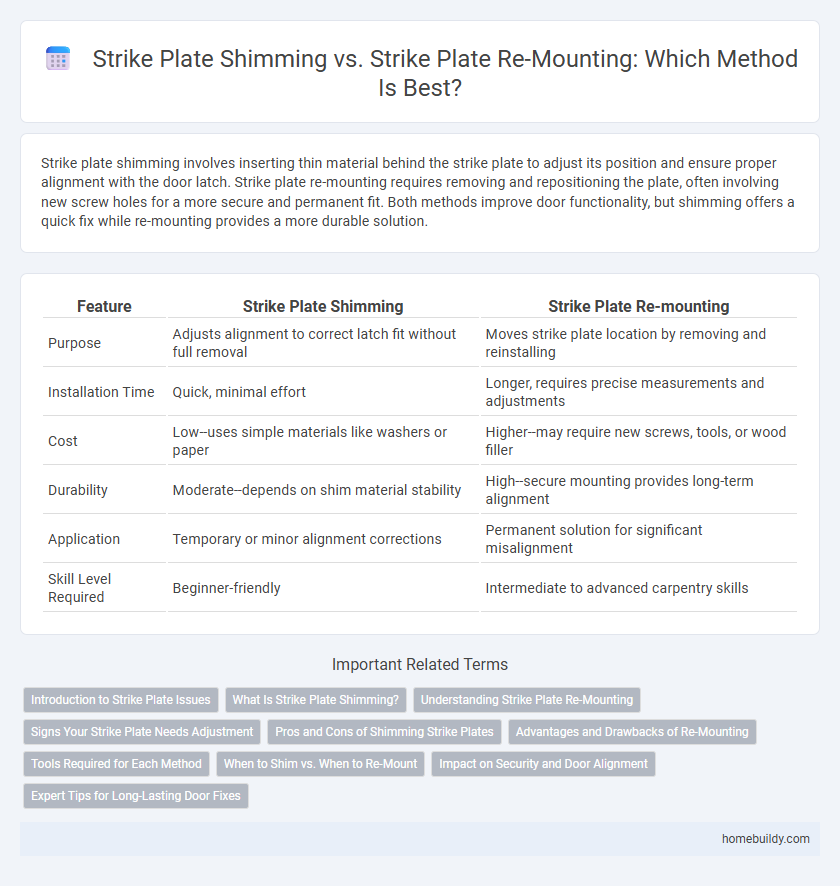Strike plate shimming involves inserting thin material behind the strike plate to adjust its position and ensure proper alignment with the door latch. Strike plate re-mounting requires removing and repositioning the plate, often involving new screw holes for a more secure and permanent fit. Both methods improve door functionality, but shimming offers a quick fix while re-mounting provides a more durable solution.
Table of Comparison
| Feature | Strike Plate Shimming | Strike Plate Re-mounting |
|---|---|---|
| Purpose | Adjusts alignment to correct latch fit without full removal | Moves strike plate location by removing and reinstalling |
| Installation Time | Quick, minimal effort | Longer, requires precise measurements and adjustments |
| Cost | Low--uses simple materials like washers or paper | Higher--may require new screws, tools, or wood filler |
| Durability | Moderate--depends on shim material stability | High--secure mounting provides long-term alignment |
| Application | Temporary or minor alignment corrections | Permanent solution for significant misalignment |
| Skill Level Required | Beginner-friendly | Intermediate to advanced carpentry skills |
Introduction to Strike Plate Issues
Strike plate issues often stem from misalignment caused by door frame settling or improper installation, leading to difficulties in latching or locking. Strike plate shimming involves inserting thin materials behind the plate to adjust alignment without removing it, providing a quick fix for minor misfits. Re-mounting the strike plate requires repositioning and securing it in a new location on the door frame, offering a more durable solution for significant alignment problems or frame damage.
What Is Strike Plate Shimming?
Strike plate shimming involves inserting thin material behind the strike plate to improve door alignment and ensure the latch engages properly without removing the strike plate from the door frame. This method corrects minor misalignments caused by door settling or frame warping, enhancing security and preventing latch wear. Compared to strike plate re-mounting, shimming is a less invasive, quicker solution that avoids drilling new holes or repositioning hardware.
Understanding Strike Plate Re-Mounting
Strike plate re-mounting involves repositioning the strike plate to align properly with the latch or bolt, ensuring secure door locking and improved functionality. This process often requires filling existing screw holes and drilling new ones to achieve precise alignment, which is crucial when shimming fails to correct misalignment issues. Effective re-mounting enhances door security and prevents premature wear on locking components by providing a consistent and stable strike surface.
Signs Your Strike Plate Needs Adjustment
Signs your strike plate needs adjustment include misaligned door latching, difficulty locking or unlocking, and visible gaps between the door and frame. Strike plate shimming corrects minor misalignment by inserting thin metal strips to reposition the plate without removing it, while re-mounting involves removing and repositioning the strike plate screws and plate for more significant alignment issues. Proper adjustment ensures smooth door operation and prevents wear on locks and door frames.
Pros and Cons of Shimming Strike Plates
Shimming strike plates is a cost-effective solution that improves door alignment without extensive hardware removal, reducing installation time and preserving existing door frames. However, shimming may provide only a temporary fix if the door or frame has significant misalignment or wear, potentially leading to frequent adjustments. In contrast, re-mounting strike plates offers a more durable and precise alignment but involves more labor, potential frame damage, and higher repair costs.
Advantages and Drawbacks of Re-Mounting
Re-mounting a strike plate ensures a precise alignment with the latch or bolt, greatly enhancing door security and reducing wear on the locking mechanism. This method addresses misalignment issues at their source, providing a more durable and reliable solution compared to shimming, which only offers a temporary fix by compensating for gaps. However, re-mounting can be more labor-intensive and may require repairing or modifying the door frame, potentially increasing installation time and costs.
Tools Required for Each Method
Strike plate shimming typically requires simple tools such as a flathead screwdriver, wood shims, and a hammer for minor adjustments without removing the existing plate. Strike plate re-mounting involves more extensive tools, including a drill, drill bits, chisel, measuring tape, and screws to reposition or deepen the strike plate for improved door alignment. Both methods demand precision but differ significantly in tool complexity and effort based on the extent of door frame modification needed.
When to Shim vs. When to Re-Mount
Strike plate shimming is ideal when minor adjustments are needed to align the latch for smooth door closing without altering the door frame. Re-mounting the strike plate becomes necessary when the existing screw holes are stripped, the plate is damaged, or the door or frame has shifted significantly, requiring a new placement to ensure proper latch engagement. Choosing between shimming and re-mounting depends on the extent of misalignment and structural integrity of the strike plate area.
Impact on Security and Door Alignment
Strike plate shimming improves door alignment by filling gaps without altering the original mounting, maintaining security while enabling smoother latch engagement. Re-mounting the strike plate involves repositioning or replacing it to fix misalignment, offering a more secure fit but potentially requiring door frame modifications. Proper strike plate adjustment enhances lock strength and door integrity, reducing forced entry risks and ensuring consistent latch operation.
Expert Tips for Long-Lasting Door Fixes
Strike plate shimming involves inserting thin metal or plastic shims behind the plate to adjust alignment and improve latch engagement, reducing wear without fully removing the hardware. Re-mounting the strike plate requires removing screws, repositioning, and securing the plate in a new location, ideal for addressing significant misalignment or door frame damage. Experts recommend shimming for minor adjustments to maintain original screw holes, while re-mounting ensures a more durable fix when the door frame is compromised or latch consistently fails to engage.
strike plate shimming vs strike plate re-mounting Infographic

 homebuildy.com
homebuildy.com